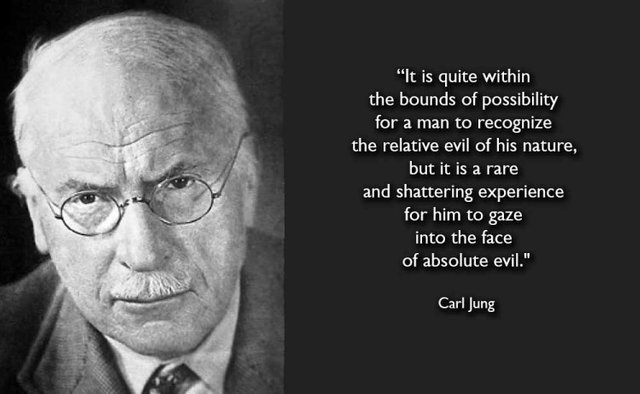The Jungian Shadow: Its Phenomenology, Detection and Conscious Integration
Psychiatrist Carl Jung’s construct of the shadow, comprised of the denied aspects of the self (1959, p. 20), conceals within itself the golden key not only to understanding the agency by which wars and feuds of all kinds tend to start, but the very solution to preventing their emergence in the first place. Such conflicts develop out of constricted, narrow views, and Jung claimed the shadow itself was the result of a narrow identification with the persona—the social mask, at the expense of the unattended aspects of the self (Bennett, 1966, p. 117). As individual attention is habitually and excessively focused on the façade of the persona, the deeper, neglected aspects of the personality continually sabotage the individual’s conscious intentions (Jung, 1959, p. 123). In order to account for these frustrations, while also avoiding their true source, the shadow is conveniently projected onto other people (Bennett, 1966, p. 119), resulting in what can often be perceived as threatening and unfriendly circumstances (Wilber, 1979, p. 82). Whether the shadow manifests as a war protester who covertly bombs public buildings, a novice guitarist who practically deifies Eddie Van Halen, or as a pro-life extremist who assassinates abortionists, it always represents the very qualities that the persona claims to lack. As such, attentive detection and conscious integration of the shadow would seem to offer a genuine solution to taming the darker aspects of humanity, as well as harnessing its highest potentials, especially if willingly practiced by a growing percentage of the world population.This essay explores a first-person, phenomenological approach to detecting and integrating the shadow, as well as a third-person, structural view of development that is believed to occur as a result of shadow integration. Drawing from both first-person experience and logical argument, based upon insights in both transpersonal psychology and Buddhist mindfulness practice, it is theorized that the cultivation of compassionate yet intentional awareness is capable not only of detecting the presence of the shadow, but also of gently confronting and integrating it into the personality in a manner which develops a more deeply attuned sense of self with the world at large, with no inherent need to deny any aspects of the self and therefore no need to project any of these aspects outside of the experienced self.
The Phenomenology of Shadow Recognition
The first sign of shadow projection appears as a strong emotional reaction to anyone or anything in the environment (Wilber, 1979, p. 94). More precisely, the first-person experience of such affect feels visceral, impulsive and automatic, more like an unconscious reflex than a conscious, intentional response (Bennett, 1966, p. 119). The instinctive reflex arising out of such affect then projects the source of the feeling outwardly onto some other person, thing or situation, often in the form of emotionally pungent criticism and blame (1966, p. 119). It is this very tendency, in fact, which can serve as the prime indicator that the shadow is in play. By becoming mindfully aware of the people to whom the persona is positively or negatively attracted, in addition to the outwardly focused perceptions which accompany such attraction, it is possible to recognize the shadow (Welwood, 200, p. 208).Surprisingly, the Christian New Testament may offer subtle insights into how the shadow can be detected and integrated. Jesus, during his famous sermon on the mount, asks,”Why do you notice the splinter in your brother’s eye, but do not perceive the wooden beam in your own eye? How can you say to your brother, ‘Let me remove that splinter from your eye,’ while the wooden beam is in your eye” (Matthew 7: 3 – 4, New American Bible)? His aim here appears to be to encourage his disciples to investigate their own first-person experience during the act of fault-finding. His emphasis is on inquiring into why and how such criticism arises, particularly on how its very development emanates from a failure to acknowledge much greater defects within themselves. In order to help his audience more clearly see how their pointed criticism originates from an over-identification with the persona, he speaks directly to the persona and says, “You hypocrite remove the wooden beam from your eye first; then you will see clearly to remove the splinter from your brother’s eye” (Matthew 7: 5, New American Bible). Interestingly, the Greek root used here, of which hypocrite is a transliteration, refers to an actor, one who plays a role. Similarly, Jung’s concept of the persona refers exclusively to the “mask of the actor” (Jung, 1959, p. 20). Additionally, Jesus suggests that two distinct qualities will emerge as a result of becoming more aware of the inner world, of mindfully attending to the shadow: 1) clarity of perception; and 2) a peaceful disposition that is motivated to help and serve others rather than to find fault and blame.
Integrating the Shadow through Conscious Awareness“I looked, and looked, and this I came to see: That what I thought was you and you,Was really me and me” (Wilber, 1979, p. 95).
As is by now evident, the contents of projection are the secret characteristics—the ‘its’—which the persona refuses to acknowledge. And ending this externalization of the personal contents of consciousness is what Jung’s former mentor, Freud, was pointing to when he proclaimed, “where id was, there ego shall be” (Freud, 1965). Here Freud is literally saying, “Where it was, I shall come to be.” Just as Ged, the lead character in LeGuin’s A Wizard of Earthsea, purposely faces and intimately embraces his own formerly destructive shadow (1975), so also is the shadow integrated by consciously addressing the persona with its own antithesis (Wilber, 1979, p. 100), so that what was formerly a problematic ‘it’ now becomes an integral part of the ‘I’, where it may now bestow its once hidden wealth upon the experience of the personality (Jung, 1959, p. 270).As previously mentioned, shadow projection is accompanied by the presence of pronounced affect (Jung, 1959, p. 38), which in turn can act as the very signal for a return to, and cultivation of, mindfulness. By deliberately diving into the felt experience of this affect, while simultaneously acknowledging its source to be interior and not exterior to the self, it is possible to come face to face with the projected contents of the personal unconscious.The first two of the Four Noble Truths of Buddhism state that: 1) suffering is the basic state of the human condition; and 2) suffering arises from desire. By bringing a greater depth of conscious awareness into the roots of the affect—the roots of the suffering, so to speak, it is possible to become aware of the underlying desire—the concealed attachment—from which the strong affect is emanating. Viewed from this perspective, the strong affect which accompanies shadow projection, usually associated with a felt tension or contraction within the body, is seen as a form of suffering. And this contraction, in the Buddhist view, is the result of a desire that is presently being either repressed (i.e., resisted) or indulged (i.e., deeply identified with). However, by diving into the depths of the attachment with compassionate, nonjudgmental yet intentional awareness, it is possible to eventually release the desire in an inward posture of kindness toward oneself (Ladner, 2004, p. 68), thus relieving the suffering.Though space does not allow for a further elaboration of what this process of mindfulness entails, it is the assertion of this essay that the same mindful process by which desires are said to be compassionately released within the context of Buddhist mindfulness practice, is the very same process by which the personal shadow can be benevolently confronted and assimilated into the experience of the self.
Shadow Integration and the Development of the EgoAs Jung indicated, once the shadow has been adequately befriended and integrated into the personality, development of the experienced self expands and unfolds (Jung, 1959, p. 340). Developmental theorist Susanne Cook-Greuter’s model of ego development, interestingly, seems to mirror Jung’s sentiments, though her conception of ego differs slightly from Jung’s. While the stages of development in the first two-thirds of her model depict the ego as differentiating itself in the direction of greater levels of autonomy, the last third of her stage-model—the postconventional stages of development—views the ego as growing toward higher levels of unity and integration with the ground of being itself (Cook-Greuter, 2004, p. 5). This higher integration involves a progressive dissolution of subject-object duality, so that all opposites are eventually absorbed and embraced (2004, p. 28). The shadow, of course, qualifies as one of the opposites to be enfolded into the unified ego, making its detection and integration absolutely essential, in this view, to human development toward more encompassing levels of wholeness and wellbeing (2004, p. 25). Cook-Greuter’s highest stage of development—the Unitive Stage—reflects a profound level of self-acceptance, so much so that there is now no unconscious need to escape what is, and therefore no need to project the shadow upon anyone or anything else (2004, p. 33). As such, a newfound simplicity and gracefulness of expression emerges in this stage as the result of unifying the once disparate aspects of the self with the rest of the world (2004, p. 33).
References
Bennett, E. A. (1966). What Jung Really Said. New York: Schocken.
Cook-Greuter, S. (2004). 9 levels of increasing embrace. Retrieved from http://www. cook-greuter.com
Freud, S. (1965). New Introductory Lectures on Psychoanalysis. London: Hogarth Press.
Jung, C.G. (1959). The Archetypes and the Collective Unconscious. Sir Herbert Read, Michael Fordham, Gerhard Adler, William McGuire (Eds.), The Collected Works of C. G. Jung (Volume 9, Part 1). Princeton, NJ: PrincetonUniversity.
Ladner, L. (2004). The Lost Art of Compassion: Discovering the Practice of Happiness in the Meeting of Buddhism and Psychology. New York: HarperOne.
LeGuin, U. K. (1975). A Wizard of Earthsea. New York: Bantam.
Welwood, J. (2000). Toward a Psychology of Awakening: Buddhism, Psychotherapy, and the Path of Personal and Spiritual Transformation. Boston: Shambhala.
Wilber, K. (1979). No Boundary: Eastern and Western Approaches to Personal Growth. Boulder: Shambhala.
Williamson, M. (1996). A Return to Love: Reflections on the Principles of A Course in Miracles. New York: Harper.



Congratulations @ses-2016! You received a personal award!
You can view your badges on your Steem Board and compare to others on the Steem Ranking
Vote for @Steemitboard as a witness to get one more award and increased upvotes!
Love jung man :)
Glad to see fellow Jungians on here :)
I also really appreciate the work of Jung as well as your clear reiteration of these complex ideas. The word "phenomenology" keeps coming up for me and I see it here again in your article. Can you explain more about this field of study, or way of studying? Thanks
Congratulations @ses-2016! You have received a personal award!
Click on the badge to view your own Board of Honor on SteemitBoard.
For more information about this award, click here
Congratulations @ses-2016! You have received a personal award!
Click on the badge to view your Board of Honor.
Do not miss the last post from @steemitboard:
SteemitBoard World Cup Contest - Semi Finals - Day 1
Participate in the SteemitBoard World Cup Contest!
Collect World Cup badges and win free SBD
Support the Gold Sponsors of the contest: @good-karma and @lukestokes